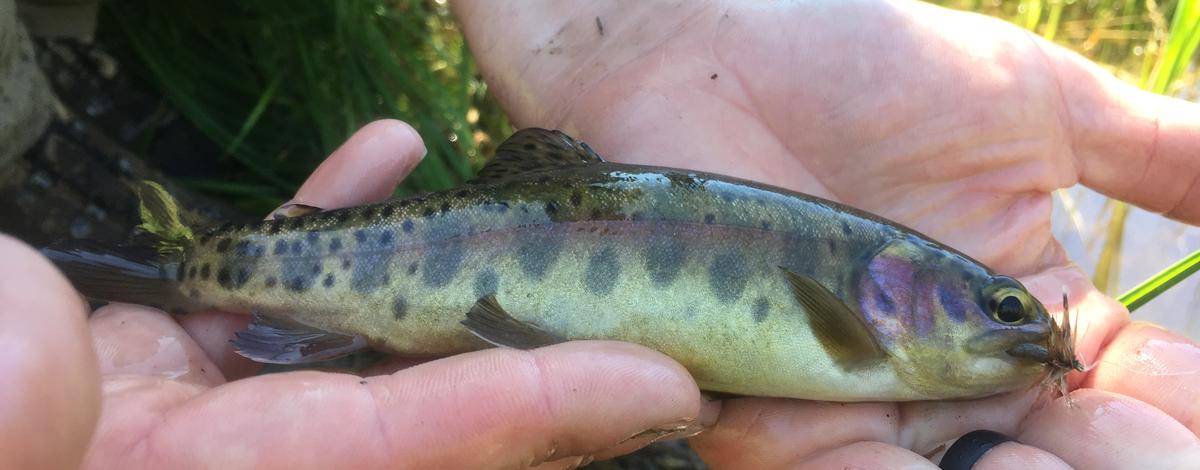High mountain lakes across Idaho’s backcountry provide some fantastic fishing in some beautiful scenery, and a handful of them are the only places you can catch some of Idaho’s more unique sportfish.
Idaho’s moutain lakes are primarily stocked with westslope cutthroat trout and sterile rainbow trout, but several mountain lakes throughout the state are reserved for unique species and fishing opportunities. These species are mostly stocked in completely closed basins, and locations are selected carefully by fisheries biologists to prevent any negative impacts to native amphibian species and downstream fisheries.
“These strategically selected high mountain lakes are some of the only places Idaho where you can catch species like arctic grayling or golden trout,” said Jordan Messner, regional fisheries manager in Fish and Game’s McCall office. “Among our top priorities for managing high mountain lakes is to provide a diversity of suitable fish species, and select mountain lakes allow us to provide these ‘boutique’ fisheries for the intrepid angler.”
During the summer, Fish and Game staff at the Southwest Region office occasionally get questions from anglers about where they can find fishing opportunities for these unique species. Anglers can find stocking records and filter them by species on the Idaho Fishing Planner to answer this question, but it helps to first understand the nuances of stocking and fishing in Idaho’s alpine lakes.
Given the remote nature of most high mountain lakes, backing a stocking truck up to the water is rarely an option. Because of this, most alpine lakes are stocked by airplane, or occasionally by biologists who backpack fish in, and the fish are almost exclusively stocked as fry (measuring less than 3 inches).
While growth rates will vary by species and water, a good general rule of thumb is that it takes about three years for fish stocked as fry in high mountain lakes to reach catchable sizes. So, if you’re looking for an alpine lake where you’ll have a good chance to hook into a “keeper” this summer, the sweet spot to look for in the stocking records is three to four years ago.
Keep reading to learn more about a trio of unique species stocked in some of Idaho’s high mountain lakes, and where you are most likely to catch them this summer in the Southwest Region. For convenience, we’ve included links to each waterbody in the Idaho Fishing Planner but would again remind anglers that they can find all of this information (and more) on their own by poking around in the historical stocking records.
Tiger Trout
A tiger trout is a sterile hybrid trout produced by crossing female brown trout with male brook trout. The name tiger trout comes from the appearance of the adult fish, which have beautiful “tiger-like stripes” across their backs. The “tiger-like” markings are called vermiculation, a worm-like pattern, which is found on the backs of all brook trout. They often exhibit a greenish cast and their fins can often bear the distinctive white trim of a brook trout.
Where to catch them:
- Granite Lake — (Stocked in 2020, 2021, 2022)
Arctic Grayling
Known for their large, sail-like dorsal fin and colorful body markings, grayling are stocked in a handful of high alpine lake throughout Idaho's backcountry. They grow slowly in these high, cold lakes, and any grayling over 12 inches should be considered a big one. Most grayling live in high alpine lakes that require strenuous hikes, so come prepared to hit the trail and break a sweat.
Where to catch them:
- Shaw Twins Lake #1 — (Stocked in 2019, 2020, 2021)
- Meadow Creek Lake — (Stocked in 2019)
- Herman Lake — (Stocked in 2018, 2021)
- Pearl Lake — (Stocked in 2018)
- Teardrop Lake — (Stocked in 2018, 2021)
- Box Lake (Nola Lake) — (Stocked in 2018, 2021)
- Buck Lake — (Stocked in 2018, 2021)
- Malony Lake — (Stocked in 2018, 2021)
- Summit Lake — (Stocked in 2018, 2021)
- Rapid Lake — (Stocked in 2018)
- Burnside Lake #2 — (Stocked in 2018, 2021)
- Coffee Cup Lake — (Stocked in 2018)
Golden Trout
One of the most colorful trout in the world that gets its name from – you guessed it – the bright golden hue of its sides, golden trout are native to high elevation streams and lakes of the southern Sierra Nevada mountains in California. While not native to Idaho, they have been introduced to several backcountry alpine lakes throughout Idaho to provide more fishing opportunities.
Where to catch them:
- Big Hazard Lake — (Stocked in 2018)
- Meadow Creek Lake — (Stocked in 2019)
- Sheepeater Lake — (Stocked in 2019)
- Summit Lake — (Stocked in 2018)
- Louie Lake — (Stocked in 2018, 2019, 2021)
- Blackwell Lake — (Stocked in 2018)
- South Tentymile Lake — (2018)
- Baron Lake #6 — (2018, 2021)

